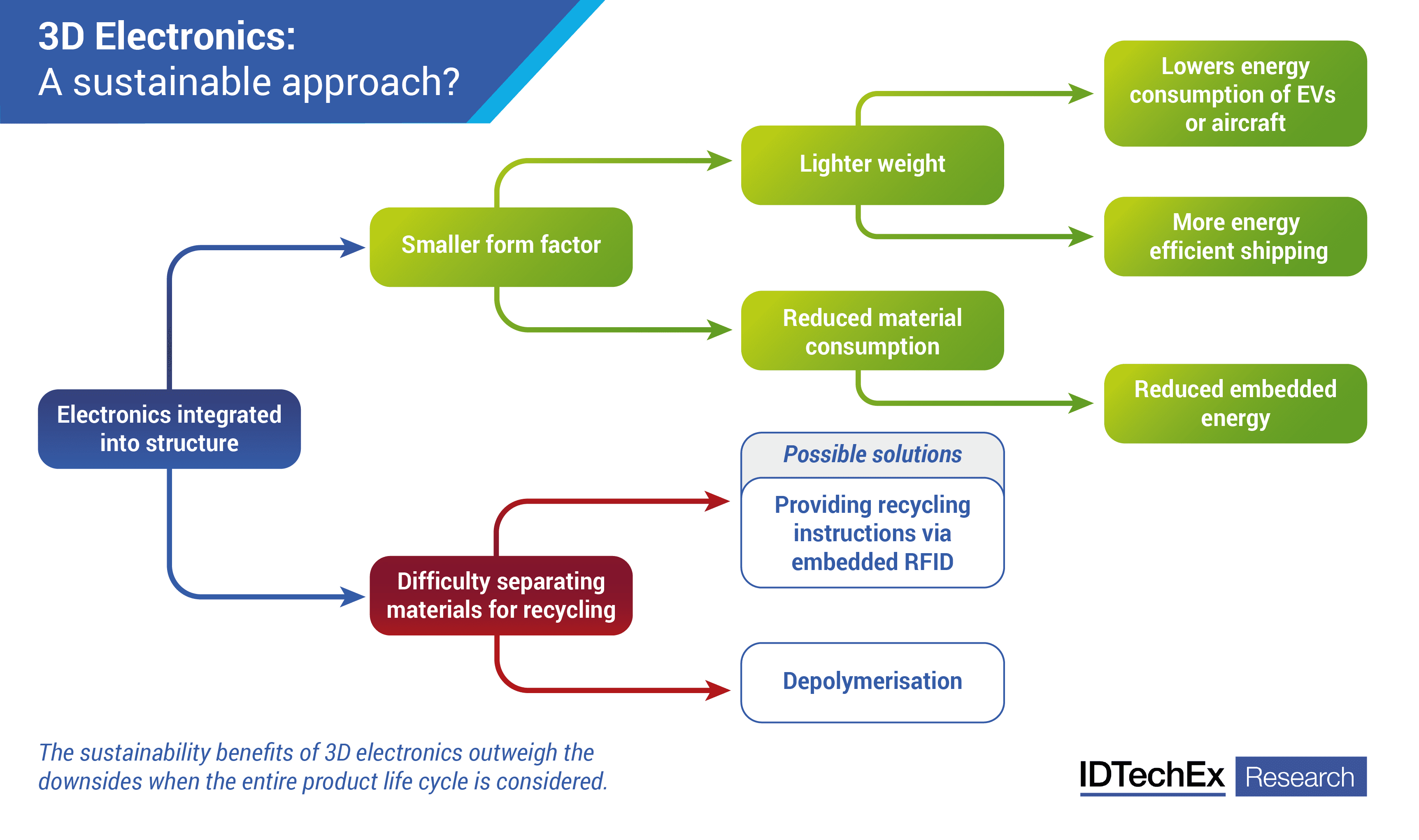As electronics being increasingly ubiquitous, there is a clear trend toward greater integration. Rather than simply making space for a rigid 2D circuit board (PCB) within the product, electronic functionality will be either mounted conformally onto surfaces or incorporated within the structural materials.
These emerging manufacturing methodologies can collectively be termed ‘3D electronics’. They offer greater design freedom, with opportunities for imaginative form factors to provide differentiation in consumer devices. However, this integration of electronic with structural functionality presents questions regarding sustainability.
Combating recycling difficulties
Ease of recycling is generally the greatest sustainability concern for 3D electronics. Mounting electronic components, such as conductive traces, surface mount devices, micro-controllers, and sensors, within or on the surface of the main structural material makes separating out the different materials for recycling more challenging. In contrast, conventional manufacturing methods mean that the electronics can be removed and then the remaining plastic recycled.
Despite this apparent difficulty, 3D/integrated electronics does offer some benefits to recyclability. The main benefit is the much-reduced material mix, which facilitates separation and sorting. 3D electronics means that components with electronic functionality can be constructed using just four different materials: for example, an LED lightbulb can be made from structural plastic, conductive ink, conductive adhesive, and the LEDs themselves. This is a substantial simplification relative to the conventionally manufactured alternative which generally incorporates a PCB.
An additional benefit of integrating electronics within 3D structures is that recycling instructions can be embedded within the product by incorporating an RFID tag. When scanned on disposal, disassembly instructions, such as the precise location of surface mount components, can be obtained along with the material composition.
Environmental benefits of 3D electronics
When assessing the sustainability of competing manufacturing methodologies, it is important to consider their environmental impact across the entire life cycle, and to also consider secondary consequences. It’s here that 3D electronics brings substantial sustainability benefits, primarily because integrating electronic and structural functionality enables a much more compact form factor as there is no need to incorporate a rigid PCB.
This smaller factor brings two main benefits: fewer materials are used, and the device is much lighter. As such, less energy is used to manufacture the materials, and shipping the device (and its constituent parts) is more efficient. Furthermore, if the 3D electronics part is used in an electric vehicle or aircraft then the reduced weight will enable further energy savings.
Given these benefits, complete life cycle analysis (LCA) generally shows a significant sustainability benefit for 3D electronics. While concerns around material separation are valid, this disadvantage is more than made up for by the reduced size, weight, and material mix. Furthermore, recycling technologies such as depolymerization that facilitate material separation are likely to become more widely utilized over time, resolving the main sustainability challenge.
The sustainability benefits of 3D electronics outweigh the downsides when the entire product life cycle is considered. Source: IDTechEx
A comprehensive overview
Extensive insight into 3D electronics, including a more detailed assessment of the sustainability challenges and benefits, can be found in the recent IDTechEx report “3D Electronics/Additive Electronics 2022-2032”. This assesses the competing technologies that will enable PCBs to be replaced with integrated electronics, saving space, weight and reducing manufacturing complexity. It covers electronic functionality to 3D surfaces, in-mold electronics (IME), and fully 3D printed electronics.
The report includes over 30 detailed company profiles based on interviews with major players across the different technologies. We also develop 10-year market forecasts for each technology and application sector, delineated by both revenue and area. We forecast the gradual decline of LDS and growth in extruded paste for consumer electronic antennas, and increased use of extrusion and aerosol, especially for automotive applications. The most substantial growth is predicted for IME, which we predict will be widely adopted in car interiors and the control panels of white goods.

